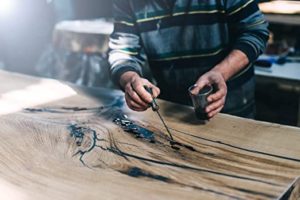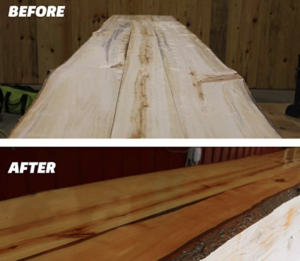Epoxy is quickly becoming one of the best woodworking things that we can use. It adds a glossy shield to beautiful wooden projects that we have created, but it also allows us to go above and beyond simple woodworking. All it takes is to discover how applying epoxy to wood projects works.
The Beauty of Epoxy
 Just consider for a moment the river tables that are so popular right now. These tables use epoxy to hold together a slab or two of wood that may never touch each other. Epoxy itself is clear, but you can add pigments to it to get a more desirable color if you want to.
Just consider for a moment the river tables that are so popular right now. These tables use epoxy to hold together a slab or two of wood that may never touch each other. Epoxy itself is clear, but you can add pigments to it to get a more desirable color if you want to.
Whether pouring epoxy on thick (like you would for a river) or applying just a thin coating, it is overall easy to work with. In fact, these two methods are the most popular way to work with it, depending on the epoxy that you have.
Is Working with Epoxy Difficult?
One common question about working with epoxy is how difficult is it to do? Epoxy itself isn’t difficult. You simply have to pour and it will basically do the rest. The tricky part is understanding that it is designed to flow. Meaning, before you pour, you will have to protect the surfaces that you do not want epoxy poured on.
Tips for Working with Epoxy
 To start, you will need to pick your wood and prep it. This may involve cutting and sanding the wood. You will also want to build a dam around the edges to prevent epoxy flow off of it (especially if you want to deep pour).
To start, you will need to pick your wood and prep it. This may involve cutting and sanding the wood. You will also want to build a dam around the edges to prevent epoxy flow off of it (especially if you want to deep pour).
It is then recommended that you pour one light coat of epoxy to seal the wood. This will lessen the risk of air bubbles in the deep pour. This first layer should be about ⅛” thick. You will then need to wait on it to set. This can take up to a few hours, though usually, it is less. When it is hardened, you will want to sand it if there are imperfections, and then clean away the dust.
Repouring is optional, depending on the thickness you want. You can add multiple layers. Each one will add to the beauty of your table.
You can finish out your table with a single last layer of epoxy or by applying wax or natural oil to the finish. This will remove sanding marks.
Keep in mind when sanding epoxy, you need to keep your mask on. This will prevent you from inhaling dust. Epoxy is 100% food safe once cured. This does not mean it is good to breathe in while you work with it.